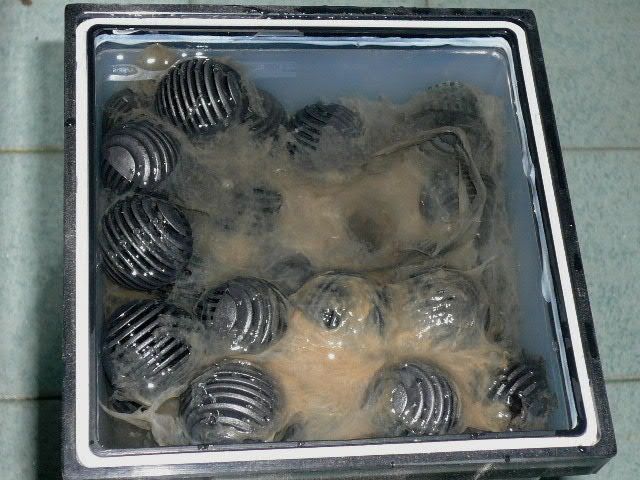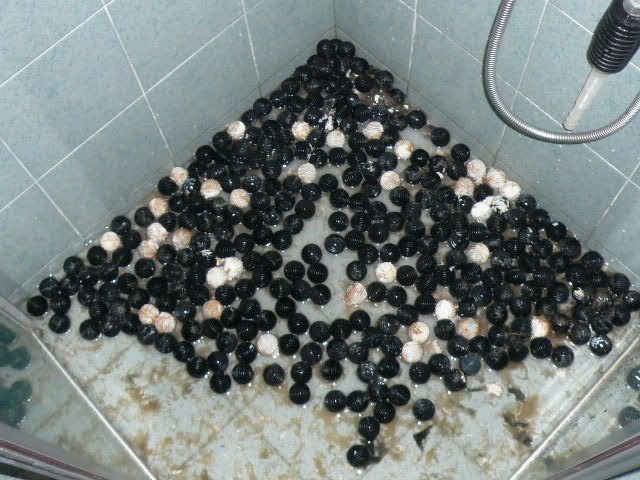
 |
|
|
|
#1 |
|
Guest
Posts: n/a
|
There has been quite an interest on denitrator recently and by starting this thread, it will provide more info for those who are interested in it.
Let me start by showing what is inside a typical denitrator:   
|

|
|
|
#2 |
|
Guest
Posts: n/a
|
The 1st picture is showing the denitrator with the top removed.
The 2nd is the content of the a matured denitrator. The black coloured ball is just normal bioball. The whitish coloured is the deniball. The 3rd is the slime collected in a plastic tub. |

|
|
|
#3 |
|
Guest
Posts: n/a
|
What is denitrator?
A denitrator is a device using nitrifying bacteria under anaerobic (i.e. without oxygen) conditions to remove nitrates. This process is called biological denitrification. What is denitrification? From www.wikipedia.org, it means: Denitrification is the process of reducing nitrate and nitrite, highly oxidised forms of nitrogen available for consumption by many groups of organisms, into gaseous nitrogen, which is far less accessible to life forms but makes up the bulk of our atmosphere. It can be thought of as the opposite of nitrogen fixation, which converts gaseous nitrogen into a more biologically available form. The process is performed by heterotrophic bacteria (such as Paracoccus denitrificans, Thiobacillus denitrificans, and various pseudomonads) from all main proteolytic groups. OR Biological Denitrification: a bacteria-mediated (i.e. biological) process in which nitrate is reduced into nitrogen gas by denitrifying bacteria (typically facultative heterotrophes) underanoxic (oxygen-free) conditions. The process requires that an electron donor (typically an organic carbon source) be present for the reaction to go to completion. Sounds complicated? I think so too and I prefer to coin as: It is a process to remove nitrogen or nitrogen groups from (a compound). Last edited by atom; 04-10-2007 at 07:34 AM. |

|
|
|
#4 |
|
Guest
Posts: n/a
|
Equation for denitrifying process:
Nitrate to Nitrite to Nitrogen Redox equation (I prefer) NO3 + 2 electrons + H+ <=> NO2 + H2O NO2 + 3 electrons + 4 H+ 1/2 N2 (nitrogen gas) + 2 H2O or taken together: NO3 + 5 electrons + 6 H+ <=> 1/2 N2 + 3 H2O |

|
|
|
#5 |
|
Arofanatic
   Join Date: Feb 2001
Posts: 269
|
Wow... Looks like my chemistry lessons many many many years ago... Anyway, thanks for the info... But I am still debating whether having a denitrator or just changing water is more feasible or make more economic sense..
|
|
|

|
|
|
#6 |
|
Dragon
     Join Date: Apr 2001
Posts: 1,510
|
yew... those bacteria slime/biofilm looks disgusting.. haha.. my mum will kill me if she sees me cleaning those things in my bathroom.. lol
can share the purpose of collecting the slime? gonna add back to the denitrator when u restart it again? any experience with sulphur denitrator? cos i think it will be way more effective den a bacteria denitrator.. gonna try when i get my 12th month bonus.. tank setup too boring after i remove all my DSBs, plants and NR1000.. |
|
|

|
|
|
#7 | ||
|
Guest
Posts: n/a
|
Quote:
Quote:
 Soon soon but not now. |
||

|
|
|
#8 |
|
Guest
Posts: n/a
|
Denitrator is not just meant for us hobbyist. It is also used in large commercial sewage plant, waste water management and even for portable water (yaks!). High level of nitrate is bad for us and even worse for infants.
In US, with the increasingly difficult prospect of supplying high-quality drinking water in areas contaminated with nitrate, the need for cost-effective nitrate removal solutions is critical. This demand for effective nitrate removal technologies has increased the interest and acceptability of biological denitrification as an attractive treatment solution. |

|
|
|
#9 |
|
Guest
Posts: n/a
|
Here is something on sulphur denitrification.
ASD: Autotrophic sulfur denitrification, a type of anaerobic denitrator utilizing elemental Sulfur as a chemical feed source for reducing nitrates, The reaction series (4 NO3 + 3 S = 2 N2 + 3 SO4) involved is acidic. It can be best tied-in with melting down a source of carbonate, thus result in excess sulfates. Last edited by atom; 04-10-2007 at 03:56 PM. |

|
|
|
#10 | |
|
Arofanatic
   Join Date: Jun 2006
Posts: 278
|
Quote:
|
|
|
|

|
 |
|
| Currently Active Users Viewing This Thread: 1 (0 members and 1 guests) | |
|
|